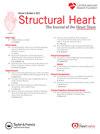房颤患者经导管主动脉瓣置换术中采用脑栓塞保护的早期结果
IF 1.4
Q3 CARDIAC & CARDIOVASCULAR SYSTEMS
引用次数: 0
摘要
背景有限的研究旨在确定在经导管主动脉瓣置换术(TAVR)中使用脑栓塞保护装置(CPDs)可能受益的患者群体。我们的目的是分析心房颤动(AF)患者在TAVR期间使用CPD的影响。方法从2017-2020年国家再入院数据库中获取合并AF诊断的成人TAVR患者的数据。在倾向评分匹配分析中比较CPD组和非CPD组的卒中、重度卒中、住院死亡率和30天再入院率。使用多变量logistic回归模型分析CPD使用与不良事件的关系。结果在100,928例符合条件的TAVR合并房颤患者中,6.9%的患者使用了CPD,平均年龄为80岁。使用CPD与较低的总卒中发生率独立相关(1.7% vs. 2.2%;优势比[OR] 0.81 [95% CI 0.68-0.98];P = 0.032),重度卒中(1.2% vs. 1.8%;或0.69 [0.55-0.86];P = 0.001),住院死亡率(0.9 vs. 1.5%;或0.56 [0.43-0.72];p & lt;0.001),且30天再入院率较低(12.7% vs. 14.7%;或0.87 [0.81-0.94];p & lt;0.001)。在高容量TAVR中心发现CPD减少了不良事件,但在低容量TAVR中心没有发现。结论在房颤患者行TAVR时使用CPD有明显的益处。在符合解剖条件的患者中,碎片捕获的潜在益处可能会被考虑,特别是当年轻和低风险的患者符合TAVR条件时。需要来自未来试验和登记的数据来进一步证实我们的发现。本文章由计算机程序翻译,如有差异,请以英文原文为准。
Early Outcomes With Cerebral Embolic Protection During Transcatheter Aortic Valve Replacement in Patients With Atrial Fibrillation
Background
Limited studies are available which aim to identify patient populations that would potentially benefit from the use of cerebral embolic protection devices (CPDs) during transcatheter aortic valve replacement (TAVR). We aimed to analyze the impact of CPD use during TAVR among patients with atrial fibrillation (AF).
Methods
Data on adult TAVR patients with a concomitant diagnosis of AF was obtained from the 2017-2020 National Readmissions Database. Stroke, major stroke, in-hospital mortality, and 30-day readmission rates were compared between the CPD and no-CPD cohorts in a propensity score matched analysis. Association of CPD use with adverse events was analyzed using multivariable logistic regression models.
Results
Of 100,928 eligible TAVR patients with AF, CPD was used in 6.9% of patients with a mean age of 80 years. CPD use was independently associated with lower overall stroke (1.7% vs. 2.2%; odds ratio [OR] 0.81 [95% CI 0.68-0.98]; p = 0.032), major stroke (1.2% vs. 1.8%; OR 0.69 [0.55-0.86]; p = 0.001), in-hospital mortality (0.9 vs. 1.5%; OR 0.56 [0.43-0.72]; p < 0.001), and lower 30-day readmission rates (12.7% vs. 14.7%; OR 0.87 [0.81-0.94]; p < 0.001). Reduction in adverse events with CPD was noted in high-volume but not in low-volume TAVR centers.
Conclusions
The present point towards clear benefits of CPD use among patients with AF undergoing TAVR. In anatomically eligible patients, the potential benefit of debris capture may be considered especially as younger and lower risk patients become eligible for TAVR. Data from future trials and registries are required to further corroborate our findings.
求助全文
通过发布文献求助,成功后即可免费获取论文全文。
去求助
来源期刊

Structural Heart
Medicine-Cardiology and Cardiovascular Medicine
CiteScore
1.60
自引率
0.00%
发文量
81
 求助内容:
求助内容: 应助结果提醒方式:
应助结果提醒方式:


